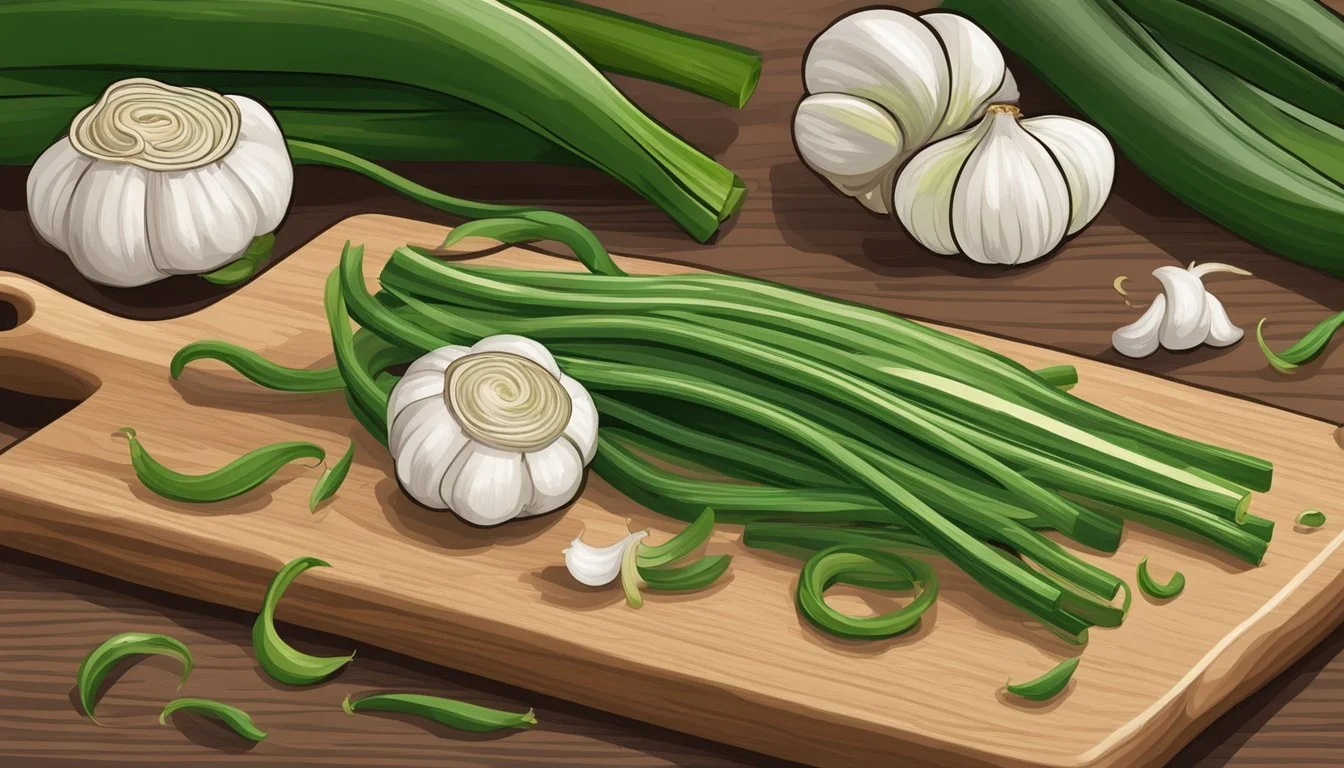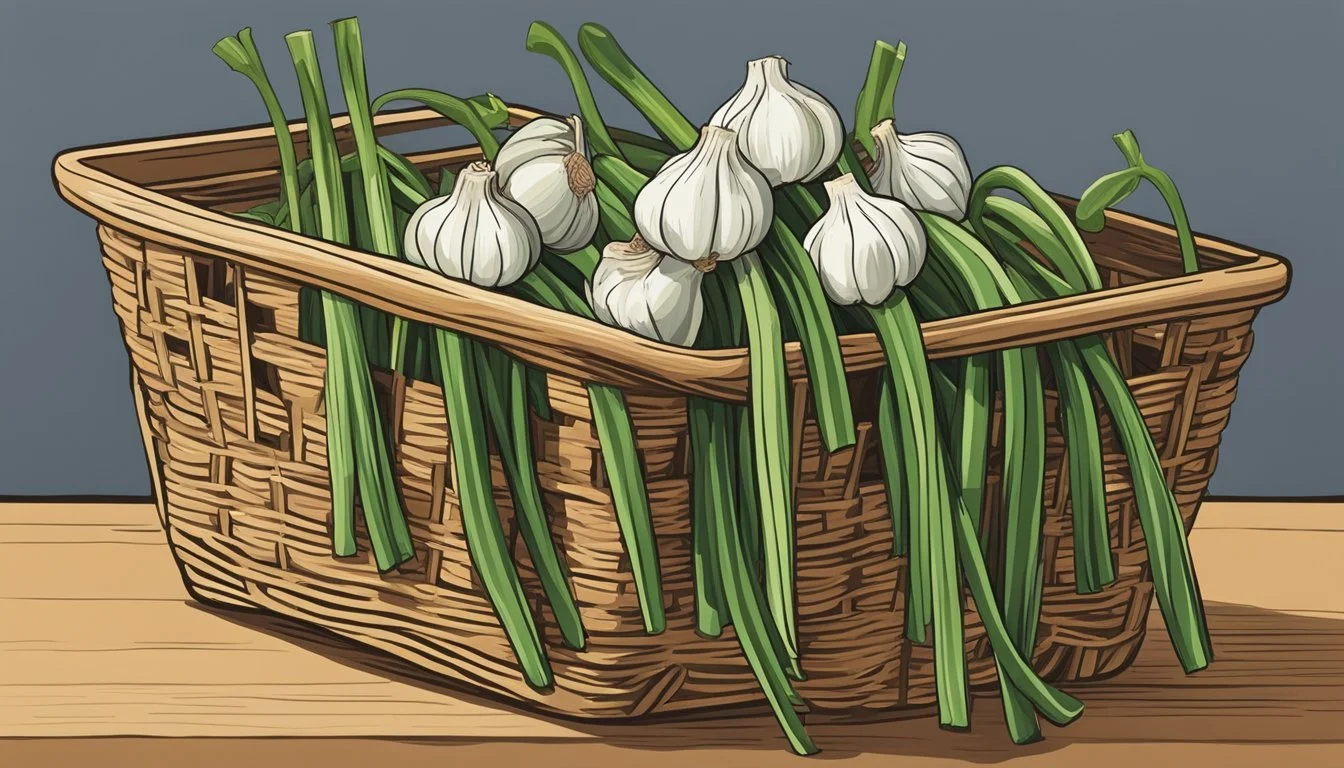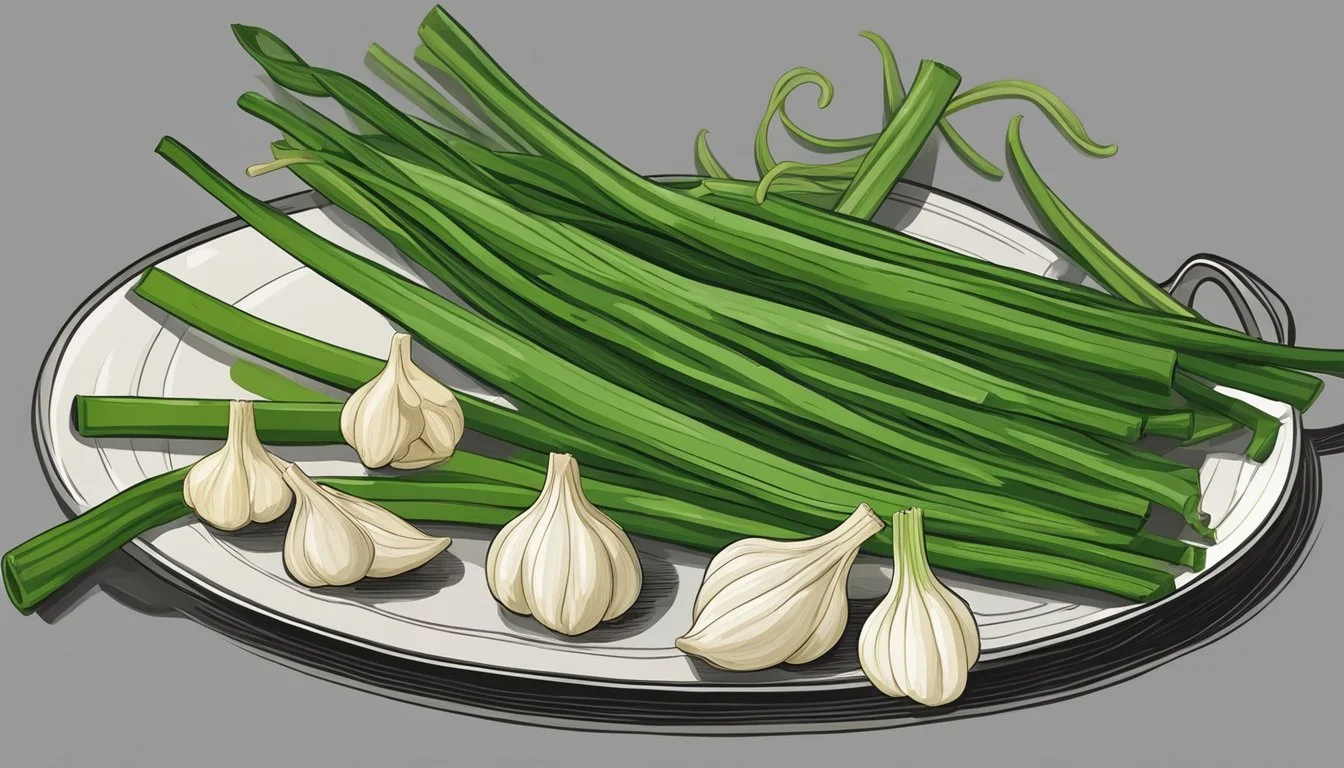How to Substitute Garlic Scapes for Garlic Cloves
A Simple Guide
Garlic (What wine goes well with garlic?) scapes, the curly shoots from the garlic plant that form before the bulbs mature, are a versatile ingredient cherished for their mild garlic flavor. Often found in farmers' markets during their brief seasonal appearance in early summer, scapes can enhance a range of dishes much like garlic cloves do. When garlic cloves are unavailable or a milder alternative is desired, scapes can be an excellent substitute, offering a gentler hint of garlic without overpowering a dish.
Utilizing garlic scapes as an alternative to garlic cloves requires understanding their unique characteristics. Where garlic cloves provide an intense, pungent flavor, scapes offer a subtler profile that works especially well in pesto, stir-fries, and sautées. To substitute, a cook may finely chop the scapes and add them to dishes in a similar quantity to chopped garlic, adjusting to taste. The key is to account for their milder flavor, which may require using more scapes than one would cloves to achieve a similar garlic presence in a recipe.
Moreover, scapes are not just a backup option but are often preferred for certain preparations due to their texture and color, which add a visual and textural appeal. Their use extends beyond just being a stand-in for garlic cloves, as they can be prepared on their own to showcase their unique qualities. From grilling or blanching to incorporating them into a creamy pasta sauce, garlic scapes provide a nuanced garlic essence that is both distinct and complementary.
Understanding Garlic Scapes
Garlic scapes are the curly, green stems from the garlic plant, harvested before they flower. As a misunderstood part of the garlic plant, scapes provide a more subtle garlic flavor and offer various culinary applications.
Characteristics of Garlic Scapes
Garlic scapes are the stalks that grow from the bulbs of Allium sativum, the garlic plant. They are usually harvested in early summer to allow the garlic bulbs to grow bigger. Scapes have a milder flavor and a crisp, green bean-like texture. They appear long and curly with a slight bulbous end, often resembling a green, twisty straw.
Culinary Uses of Garlic Scapes
Scapes are versatile in the kitchen and can be used in a range of culinary preparations. They are excellent when sautéed in oil or butter and can be substituted in recipes calling for garlic cloves. Here is a comparison of how one might substitute scapes for garlic cloves in recipes:
Raw: Finely chop garlic scapes to use in salsas, pestos, or salads.
Cooked: Use scapes to infuse a gentle garlic essence in soups, stir-fries, and pasta dishes.
Nutritional Profile
Garlic scapes, being part of the allium vegetable family, share a similar nutritional profile to garlic cloves. They contain vitamins such as Vitamin C and Vitamin K, along with a range of minerals like manganese and calcium. Scapes are low in calories, making them a healthy addition to a variety of dishes.
Harvesting and Storage
In the lifecycle of garlic, scapes are the tender, flavorful stems that emerge before the flowers, and their timely harvest is essential for both culinary use and proper storage.
When to Harvest Garlic Scapes
Garlic scapes are ready for harvest when they begin to form a loop or spiral, indicating the scape is still tender and not overly mature. They should be cut with sharp shears or scissors just above the point where they emerge from the leaves to prevent damage to the plant.
Storing Garlic Scapes
Once harvested, garlic scapes should be stored in a cool, dry place away from direct sunlight to maintain their freshness. They can be refrigerated in a plastic bag for about two to three weeks. For longer storage, garlic scapes may be blanched and then frozen to preserve their flavor and texture for use throughout the year.
Preparing Garlic Scapes for Cooking
When one prepares garlic scapes for cooking, the initial focus should be on proper cleaning and cutting techniques. Once prepped, garlic scapes can be sautéed, grilled, or even pickled to bring out their unique garlicky flavor.
Cleaning and Cutting Techniques
Cleaning: Before cutting, garlic scapes should be thoroughly washed under cool water to remove any dirt or debris. They should be gently patted dry with a towel.
Cutting: The tough ends of the garlic scapes, about one inch from the bottom, are to be trimmed off. The scapes are then to be chopped into 2-3 inch pieces, which are ideal for cooking and ensure even flavor distribution.
Cooking Methods: Saute, Grill, and Pickle
Saute: To sauté garlic scapes:
Heat a tablespoon of oil or butter in a skillet over medium-high heat.
Add the chopped scapes and cook for 3 to 5 minutes until browned and tender, stirring occasionally.
Grill: For grilling garlic scapes:
Toss in oil and season as desired.
Place on a preheated grill, turning occasionally until they have grill marks and are tender, usually about 10 minutes.
Pickle: To pickle garlic scapes:
Combine vinegar, water, salt, and optional spices in a pot and bring to a boil.
Pack garlic scapes into jars and pour the boiling brine over them.
Seal jars and process according to safe canning practices or refrigerate.
Substituting Garlic Scapes for Cloves
When cooking with garlic scapes, knowing the appropriate conversion ratio and how to adjust for garlic intensity can lead to satisfying results as a substitute for garlic cloves.
Garlic Scape to Garlic Clove Conversion
One can substitute two garlic scapes for a single garlic clove. This is based on the general equivalency for the flavor garlic scapes impart in a dish. It's important to note that garlic scape sizes and their pungency can vary, so adjustments may be necessary:
Small scapes: Use two scapes for a milder garlic flavor.
Large scapes: Use one or one and a half, as they can have a stronger flavor.
Garlic Scapes Garlic Cloves Equivalent 1 small scape ½ clove 2 small scapes 1 clove 1 large scape 1 clove 2 large scapes 1½ - 2 cloves
Adjusting Recipes for Garlic Intensity
Garlic scapes may have a milder flavor than garlic cloves, necessitating adjustments to achieve the desired intensity in recipes:
Taste as you go: After adding garlic scapes, taste the dish and add more if needed.
Minced garlic: If a recipe calls for minced garlic, mince or finely chop the garlic scapes to ensure the flavor is distributed evenly throughout the dish.
Sauteing: Garlic scapes can also be sautéed before being added to recipes, which can mellow their flavor and make them more akin to the taste of sautéed garlic cloves.
A confident approach to substituting garlic scapes for cloves involves beginning with the above conversion, and then adjusting according to the particular garlic intensity preferred in the dish.
Incorporating Into Recipes
When using garlic scapes in place of garlic cloves, chefs may need to adjust quantities due to the milder flavor of scapes. They can be incorporated directly into recipes where garlic is required, lending a subtle, less intense garlic taste.
Homemade Garlic Scape Pesto
For a twist on traditional pesto, garlic scapes can be substituted for garlic cloves. Combine garlic scapes with fresh basil, parmesan cheese, pine nuts, and olive oil in a food processor. The ratio to use is generally one garlic scape per garlic clove, but taste and adjust according to preference.
Adding to Soups and Sauces
Garlic scapes can be sliced and added to soups and sauces much like one would use garlic cloves. They should be sautéed first to soften and mellow their flavor. Typically, a single garlic scape can substitute for one garlic clove in most recipes. Remember to chop finely or puree for a smooth texture in the final dish.
Creating Compound Butter and Salad Dressings
Compound butter can be enhanced with finely chopped garlic scapes. Mix them into softened butter, forming a log to chill and slice as needed. This will impart a fresh, garlicky flavor that is excellent on warm bread or over grilled meats.
To craft a garlic scape vinaigrette, whisk together chopped garlic scapes with extra virgin olive oil, vinegar, and seasoning. One or two chopped scapes per dressing batch will suffice. Let the dressing meld for a few hours for flavors to infuse.
Alternatives to Fresh Garlic Scapes
In instances when fresh garlic scapes are not available, other ingredients can mimic their mild garlic flavor and crunchy texture. These alternatives provide versatility in both usage and flavor, accommodating a range of dishes.
Using Garlic Scape Powder and Infused Oils
Garlic Scape Powder provides a convenient and long-lasting option. Cooks can sprinkle it onto dishes to introduce a subtle and earthy garlic taste that is characteristic of the fresh scapes. The powder can be particularly useful in seasoning mixes where a smooth texture is desired.
Infused Oils, such as garlic scape oil, capture the essence of garlic scapes by steeping them in a quality oil base. These oils offer a dual function: they carry the garlic scape flavor and add the rich mouthfeel of the oil. A drizzle of garlic scape infused oil can finish off pasta dishes, salads, or be used as a base for marinades.
Other Garlic Substitutes: Chives, Shallots, and Scallions
Garlic Chives: Similar to garlic scapes but with a more delicate texture and a flavor that is a blend of garlic and onion, they are best used fresh or added at the end of cooking to maintain their flavor and crispness.
Shallots: These offer a subtle hint of garlic married with the complexity of onion and work exceptionally well in dressings, sauces, or as a base ingredient for various culinary preparations.
Scallions (Green Onions): Although they lack the garlic intensity of scapes, scallions can add a fresh, oniony bite that suits many dishes that would typically use garlic scapes, especially when used in larger quantities.
In each case, they should adjust their usage to taste, considering the unique flavor profiles and strengths of these substitutes.
Health Considerations
When substituting garlic scapes for garlic cloves, one should consider the nutritional impact as part of their dietary health. Garlic, whether in the form of scapes or cloves, contributes beneficial nutrients to the diet, with distinct profiles that are important for overall wellness.
Benefits of Garlic in Diets
Garlic has been recognized for its health-promoting properties. Both garlic cloves and scapes are low in sodium and contain compounds that may contribute to the aromatic and flavor qualities sought after in culinary applications. These compounds may also have positive implications for one's health. The inclusion of garlic is noted for potential cardiovascular benefits, as well as for its anti-inflammatory and antibacterial properties.
Energy, Protein, and Fiber Content
The nutritional content of garlic can slightly vary between its raw and cooked forms. A standard serving of raw garlic provides a meager amount of energy but is a good source of proteins and dietary fiber, critical for maintaining the body's normal functions.
Nutrient Raw Garlic (per 100g) Cooked Garlic (per 100g) Garlic Scapes (per 100g) Energy 149 kcal 153 kcal 30 kcal Protein 6.36 g 6.31 g 3.3 g Fiber 2.1 g 1.2 g 2.8 g
Although garlic scapes have a lower energy and protein content compared to garlic cloves, they contribute a substantial amount of dietary fiber to the diet, especially when consumed raw. Cooked garlic maintains most of its protein but may see a decrease in fiber content. It’s essential to consider these differences when substituting garlic scapes for cloves, as it can affect the energy, protein, and fiber intake of an individual.
Purchasing Garlic Scapes
When seeking out garlic scapes, one must pay attention to the places they frequent and the season. Garlic scapes are typically harvested once a year and are known for their mild garlic flavor.
Finding Garlic Scapes at Local Farmers Markets
One can often find garlic scapes at local farmers markets during their limited seasonal window. Vendors at these markets usually sell scapes that are freshly harvested, providing consumers with premium quality. Shoppers should:
Inquire with stallholders at their local farmers market about the availability of garlic scapes.
Look for signs or postings that may indicate a vendor specializes in garlic or related produce.
Seasonal Availability
Garlic scapes are seasonal, typically available in late spring to early summer, depending on the region's climate. Here's what shoppers need to know:
Understand that garlic scapes are harvested once the garlic plant begins to form a flower stalk, generally in June.
Plan to purchase scapes within this fleeting time frame to ensure freshness and availability.
Culinary Tips and Tricks
When substituting garlic scapes for garlic cloves in cooking, one can maintain the desired garlic flavor in dishes while adding a unique visual appeal. Here are specific tips to effectively use garlic scapes for both flavor enhancement and as a garnish.
Enhancing Flavors with Garlic Scapes
Garlic scapes offer a milder flavor compared to garlic cloves. They can be used as a replacement in recipes where garlic is not the dominant flavor. To enhance the flavor of garlic scapes, cooking them is essential. One can saute them in a bit of oil until tender, which usually takes about five to seven minutes. Blanching is another method, especially useful when preparing scapes for use in pesto or hummus, as it softens the texture and mutes the strong onion flavor. Adding a squeeze of lemon juice can balance the mild garlic taste, creating a pleasing seasoning that complements other ingredients such as asparagus or ramps.
Garlic Scapes as a Garnish
While garlic scapes have a milder flavor, their unique shape makes them an excellent candidate for use as a decorative garnish. After cooking garlic scapes, one can chop them into fine pieces and sprinkle them over the dish to add color and a hint of garlic. For a bolder statement, entire scapes can be grilled or battered and fried until crispy, then placed atop entrees or side dishes. The visual appeal of garlic scapes adds a touch of elegance and professionalism to the presentation of the dish.








